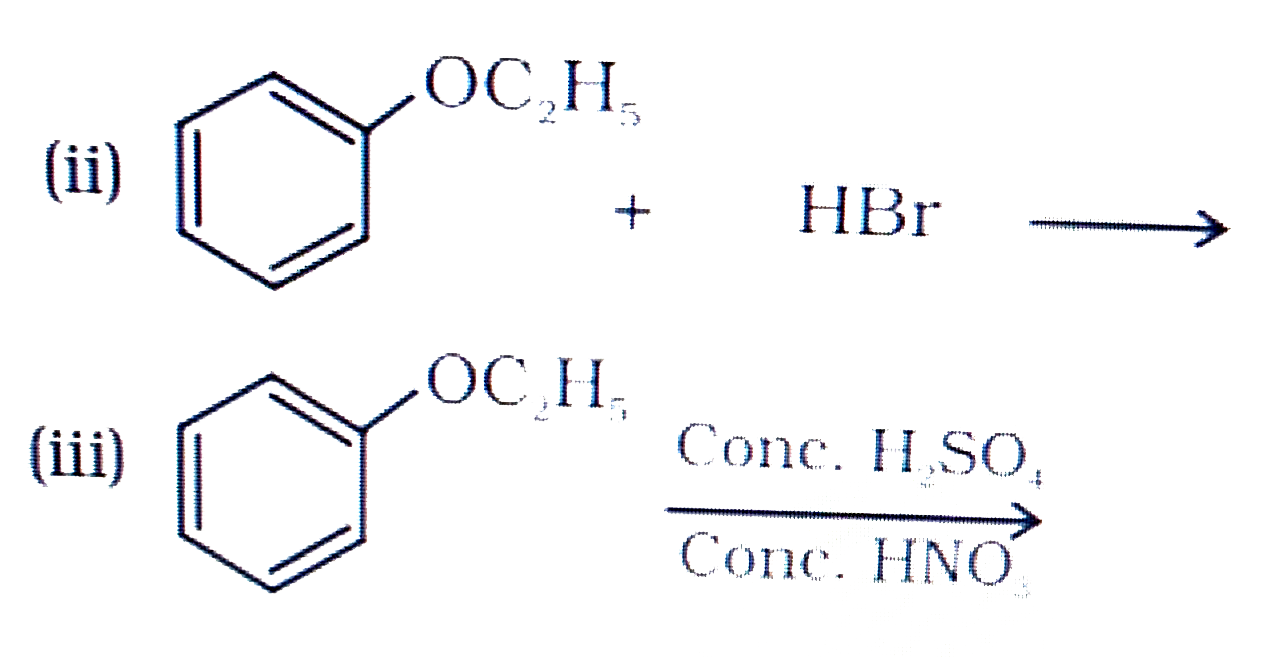Consider the following reactions
(1) (CH3)3CCH(OH)CH3conc.H2SO4−−−−−−−→
(2) (CH3)2CHCH(Br)CH3conc.KOH−−−−−−→
(3) (CH3)2CHCH(Br)CH3(CH3)3CO−K⊕−−−−−−−−−−→
(4) (CH3)2C−CH2 | OH −CHOΔ−−→
Which of these reaction(s) will produce Saytzeff product?
(1) , (2) and (4)
(3) only
(4) only
(2) and (4)
The correct Answer is:A
To determine which reactions produce Saytzeff products, we need to analyze each reaction step by step.
Step 1: Analyze Reaction 1
Reaction: (CH₃)₃C(OH)CH₃+conc.H₂SO₄→?
1. Identify the structure: The starting compound is tert-butyl alcohol, which has a hydroxyl (-OH) group.
2. Dehydration reaction: When treated with concentrated sulfuric acid, the -OH group is removed, leading to the formation of a carbocation.
3. Carbocation stability: A tertiary carbocation is formed, which is stable.
4. Rearrangement: A 1,2-methyl shift can occur to stabilize the carbocation further.
5. Formation of alkene: The elimination of a proton leads to the formation of a double bond.
6. Product: The major product is an alkene with more substituents on the double bond, which is a Saytzeff product.
Step 2: Analyze Reaction 2
Reaction: (CH₃)₂CHCH(Br)CH₃+conc.KOH→?
1. Identify the structure: The starting compound is an alkyl bromide.
2. Base-induced elimination: Concentrated KOH acts as a strong base, promoting the elimination of HBr.
3. Formation of alkene: The base abstracts a proton from the carbon adjacent to the carbon bearing the bromine, leading to the formation of a double bond.
4. Product: The major product will be the more substituted alkene, which is a Saytzeff product.
Step 3: Analyze Reaction 3
Reaction: (CH₃)₂CHCH(Br)CH₃+(CH₃)₃CO⁻K⁺→?
1. Identify the structure: The starting compound is again an alkyl bromide.
2. Bulky base: The base used here is a bulky base (tert-butoxide), which prefers to abstract the least hindered hydrogen.
3. Formation of alkene: The bulky base will remove the hydrogen from the less substituted carbon, leading to the formation of a double bond.
4. Product: This will result in the formation of the less substituted alkene, which is a Hofmann product, not a Saytzeff product.
Step 4: Analyze Reaction 4
Reaction: (CH₃)₂C(OH)CH₂CHO+Δ→?
1. Identify the structure: The starting compound is a secondary alcohol with an aldehyde group.
2. Dehydration reaction: Heating will lead to dehydration, removing -OH and -H to form a double bond.
3. Formation of alkene: The double bond will form between the carbon bearing the -OH group and the adjacent carbon.
4. Product: The major product will be the more substituted alkene, which is a Saytzeff product.
Conclusion
Saytzeff Products:
- Reaction 1 produces a Saytzeff product.
- Reaction 2 produces a Saytzeff product.
- Reaction 4 produces a Saytzeff product.
- Reaction 3 produces a Hofmann product.
Final Answer:
Reactions 1, 2, and 4 will produce Saytzeff products.
---
Reaction: (CH₃)₃C(OH)CH₃+conc.H₂SO₄→?
2. Dehydration reaction: When treated with concentrated sulfuric acid, the -OH group is removed, leading to the formation of a carbocation.
3. Carbocation stability: A tertiary carbocation is formed, which is stable.
4. Rearrangement: A 1,2-methyl shift can occur to stabilize the carbocation further.
5. Formation of alkene: The elimination of a proton leads to the formation of a double bond.
6. Product: The major product is an alkene with more substituents on the double bond, which is a Saytzeff product.
Reaction: (CH₃)₂CHCH(Br)CH₃+conc.KOH→?
2. Base-induced elimination: Concentrated KOH acts as a strong base, promoting the elimination of HBr.
3. Formation of alkene: The base abstracts a proton from the carbon adjacent to the carbon bearing the bromine, leading to the formation of a double bond.
4. Product: The major product will be the more substituted alkene, which is a Saytzeff product.
Reaction: (CH₃)₂CHCH(Br)CH₃+(CH₃)₃CO⁻K⁺→?
2. Bulky base: The base used here is a bulky base (tert-butoxide), which prefers to abstract the least hindered hydrogen.
3. Formation of alkene: The bulky base will remove the hydrogen from the less substituted carbon, leading to the formation of a double bond.
4. Product: This will result in the formation of the less substituted alkene, which is a Hofmann product, not a Saytzeff product.
Reaction: (CH₃)₂C(OH)CH₂CHO+Δ→?
2. Dehydration reaction: Heating will lead to dehydration, removing -OH and -H to form a double bond.
3. Formation of alkene: The double bond will form between the carbon bearing the -OH group and the adjacent carbon.
4. Product: The major product will be the more substituted alkene, which is a Saytzeff product.
Saytzeff Products:
- Reaction 1 produces a Saytzeff product.
- Reaction 2 produces a Saytzeff product.
- Reaction 4 produces a Saytzeff product.
- Reaction 3 produces a Hofmann product.
Reactions 1, 2, and 4 will produce Saytzeff products.
Similar Questions
Consider the following reactions :
(a) (CH3)3CH(OH)CH3conc.H2SO4−−−−−−−→
(b) (CH3)2CHCH(Br)CH3(alc.KOH)→
(c ) (CH3)2CHCH(Br)CH3((CH3)3)OΘK(⊕))→
(d) (CH3)2C∣OH−CH2−CHOΔ−−→
Which of these reaction (s) will not produce Saytzeff product ?
View SolutionProduct formed in the following reaction is CH3CH2CH(OH)CH3H2SO4−−−→
View Solution
Knowledge Check
In this reaction , (CH3)3C−CH2OHConc.H2SO4−−−−−−−−→170∘CX
X isA(CH3)2C=CHCH3BCH3≡CHC(CH3)2CHCH2CH3DCH3−CH2−C∣CH3=CH2
Predict the products of the following reactions:
(i) CH3−CH2−CH2−O−CH3+HBr→

(iv) (CH3)3C−OC2H5HI−−→
View SolutionConsider the following reaction CH3−CH=CH2Br2/NaCl−−−−−−→ Product of the reaction will be
View SolutionWhat will be product in the following reaction
CH3−CH2−CH2−CH3KMnO4−−−−→?
View SolutionIn the given reaction CH3−CH2−CH2−O−CH2−CH3Conc.Hl−−−−→(X)+(Y)
View SolutionComplete the following reaction CH3−C∣CH3=CH−CH3H2,Ni−−−→?
View SolutionConsider the following reactions
I.
II.(CH3)2C∣OH−CH2−CHOΔ−−→
III. (CH3)2CHCH2−C∣FH−CH3CH3O−Na+−−−−−−−−−−→Δ
IV. (CH3)2CH−C∣BrH−CH3(CH3)3CO−k+−−−−−−−−−−→
Which of these reaction will not produce Hoffmann product?
View SolutionWrite the mechanism of the following reaction :
2CH3CH2OHConc. H2So4−−−−−−−→413KCH3CH2−O−CH2−CH3
View Solution
